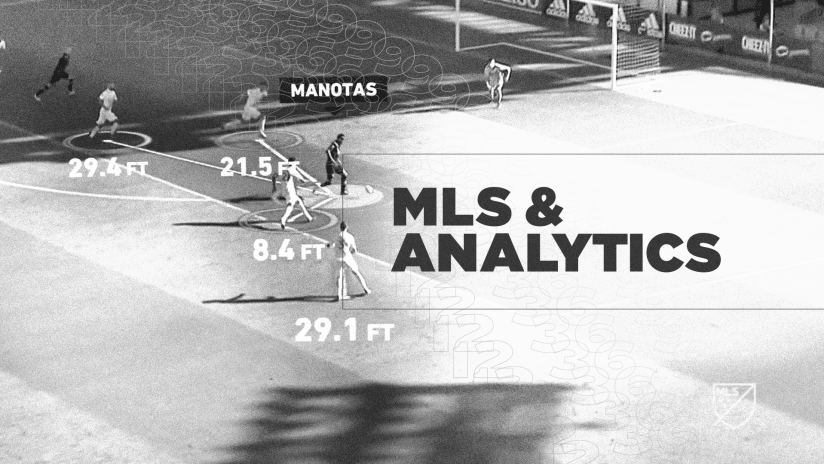Thanks, in part, to the Michael Lewis book Moneyball, and subsequent Hollywood film starring Brad Pitt, analytics in American sports have increasingly entered the mainstream consciousness.
From a distant, little-understood part of the sports world, data and analytics have now been thrust into our general sports discourse.
Moneyball told the story of Oakland Athletics general manager Billy Beane, who embraced advanced statistics in baseball, with a Harvard University economics grad as his right-hand man — a so-called nerd among jocks. It started a revolution in the sport, with the A's regularly outperforming the expectations that came with their payroll. Franchises started to adopt their methods and build on it. Now, the game of baseball is dominated by quant-based thinking.
Soccer hasn't exactly followed that same path.
A game of constant flow and evolving context, soccer data is tougher to harness. But that doesn't mean it's not already present in everything you're seeing week-to-week in matches across the globe. Some of the world's most successful teams have incorporated data and analytics into their club and it's ingrained in decision-making alongside traditional methods of analysis, player recruitment, scouting and much more.
Below are three real-world examples of the way in which soccer analytics are impacting MLS, as clubs increasingly lean on data and analytics for insights into various aspects of their operations, the insatiable desire to find the edge that helps tilt probabilities of success in their favor.
Analytics pay off in recruitment
There are quality soccer players in every corner of the globe.
This past winter, MLS clubs acquired players from 33 different countries including the United States and Canada. GMs like LAFC's John Thorrington are expanding their scouting networks and, with a growth in data, video and personal networks across the league, the soccer world is getting smaller.
When a club identifies it could use an upgrade at center mid, how do you begin sifting through all the options? The job of analysts isn't to replace traditional scouting techniques and experts, but to enhance and support them.
“In data and analytics, we’re trying to make the work of others easier," FC Cincinnati director of soccer analytics Alexander Schram told MLSsoccer.com. "For instance, they don’t have to look at the Czech Republic league. We can narrow it down to three players per position that they should be looking at, or maybe one. They don’t have to waste time looking at players who are not interesting to us.”
The technical staff identifies characteristics for each position and the associated budget. Then the analysts go to work. In other instances, there are specific players presented and analysis requested to excavate more information. For instance, Schram noted how FC Cincy put together 50-60 dossiers on potential acquisitions this offseason alone, including scouting and analytical information on each target.
Even after narrowing the group down to a shortlist of players, data will dictate the game video on which to concentrate.
“There are so many players over the world, there’s so much video," New England Revolution analyst Tim Crawford said. "Are you going to watch 10 games of every player? Maybe you start with one game. But how do you know if it’s his best day or his worst day? We can help point out which games were his best and worst.”
“For me, player recruitment and the optimization of it is actually the place where analytics can make the largest amount of difference," Toronto FC director of analytics Devin Pleuler said. "I’d say it’s where I can provide 80 percent of my value. ... Having an efficient scouting structure that allows data to cover huge swaths of the world, and doing due diligence faster with confidence, you can become a lot more efficient in the transfer market which means millions of dollars in value gains.”
“I believe data is more essential in recruitment, it’s how you can narrow down players," Colorado Rapids first team analyst Jase Kim added. "Data can filter players for you. If you look at the recruitment we’ve made in the last 18 months, it’s been very good.”
Data is also useful for domestic players. Over the last 18 months, the Rapids acquired a large number of domestic-based players, making calculated decisions on younger players in need for a fresh start, like Jonathan Lewis, Lalas Abubakar and Auston Trusty to go with Designated Player Younes Namli and young winger Braian Galvan from Argentina.
The Rapids' play improved dramatically after a coaching change in May of 2019 and continued into 2020 with wins over D.C. United and Orlando City SC as the team is almost completely turned over from the end of 2017.
“You use data to filter targets, then coaches give their opinions," Kim said.
Video analysis evolves
For in-house insights, analysts work in conjunction with the coaching staff to analyze their own players and identify teaching moments and avenues of improvement. Since soccer is a context-based sport, unlike baseball where there are a set number of permutations for every play, it's impossible to rely solely on numbers. It's a combination of data and coaching insights.
For instance, right after a game, a coach can request every pass attempt by a specific player (an example of an all pass attempt video for Philadelphia's Brenden Aaronson follows below). That process is automated and instead of manually coding a game, a video analyst marks timestamps for specific moments. Within those moments, coaches can more easily find meaningful insights.
“We want to get players into pockets – I don’t want to give away too much, but there are pockets we want to get certain players into certain pockets," Kim carefully explained. "How many times does that happen in a game? That’s subjective, depending on the situation. … So we show the player, okay, here are these moments. Here are examples of when we could have gotten into that pocket, but didn’t. We try not to numericalize it, we try to teach players like ‘this is what we didn’t do, here’s what we need to do.’ That’s why video is such an important tool these days.”
The pockets Kim talks about are specific areas on the field rather than a more general areas such as "the final third." These smaller, defined patches of space can be advantageous to an attacking team.
“We’ll always have to combine this with video," Schram added. "In the end, you cannot show a player a spreadsheet, you have to refer to a video. But we can use the tracking data to help our video analysts. Let’s say we have five specific moments in a game they know the coaches want to see, because there is specific tactical implementation going on, you can use the [player] tracking data to find [other] similar moments.”
“I’d rather have 10 moments where our assistant coach sees something, then we can show the player those 10 moments and say this is what you should have done," Kim said. "Rather than saying ‘hey, here’s the data. Look at it.’ Data doesn’t mean anything unless it’s driven towards a purposeful direction.”
Fresh take on match insights
Everything in soccer is contextual. Data and analytics are no different.
“As a club, we believe analytics deserves a seat at the table," Nashville SC director of strategy and analytics Oliver Miller-Farrell said. "It’s a table with other seats. We still very much value experience, instincts and different perspectives. We don’t see analytics as a seasoning on the club, it’s a real ingredient of how we do things.”
Philadelphia Union data analyst Dean Costalas prepares scouting reports for the club's upcoming opponents, in which he watches recent games and comes up with a summary. This includes style of play, areas of possession build, set piece tendencies, substitution patterns and much more.
“It’s about building a story for the opponent and data is a piece of it," said Costalas. "You can’t just look at clips and be like ‘wow, they do this in building possession’ but it’s about building the story. What do I see watching the game live? Then it’s incorporating data from different phases of the game. Do the numbers back that up?”
It's the same way with expected goals.
That metric, which assesses the chance of a shot becoming a goal, is a valuable way to measure the quality of chances. It's regarded as a very useful tool and it has been proven in studies to be a better predictor of league position than actual goals scored.
“It adds really good perspective, a little clearer than the results," Crawford said. "Soccer can have so much luck involved. Expected goals can show you aside from the luck. Obviously, there’s finishing ability too, but it neutralizes everything a little bit."
But while mainstream soccer punditry has largely embraced the use of expected goals in recent years, the data analysts are already going a step further to provide a far more complete picture.
For instance, game states play a big factor and part of an analyst's job is to identify these. A road team scores an early goal and sits back, tipping xG away from them as they play more cautious with the lead. Or when a team has multiple chances in the same sequence, it leads to an inflated xG measurement. Say a forward takes a shot from just inside the 18-yard box but the ball crashes off the crossbar then a teammate puts in the rebound, that sequence may get a total of 1.1 xG between both shots.
“Expected goals is really useful but you have to be careful," Costalas said." When I’m reviewing a game, you break it down and see that a team is higher than they thought, but you find 60 percent of their xG comes from one sequence. Sometimes you have to remove a portion of that because it’s one sequence. That’s what you’re really looking for in expected goals: Let me look at the number of sequences where there are goal-scoring opportunities and let’s measure it that way.”
Pleuler shares some of the same reservations. Like everything else in data and analytics, context is paramount.
“I’m not actually a huge fan of expected goals as a standalone metric, but a lot of our metrics use expected goals as a unit or a currency," he said. "So, instead of looking at a game for this team had this many expected goals, we look at things on a more granular basis. We say, this pass increased our chances of scoring on this possession by this amount. That amount is measured in expected goals. But we don’t look at expected goals by itself.”
Overall, though, the embracing of expected goals has added a layer of context beyond mere results that coaches, in some case unwittingly, have been after for some time.
“I love the idea of expected goals, it’s definitely the way I watch the game. It’s funny, because it’s something the coaches give me crap for but they watch the game the same way," added Crawford. "They’ll say ‘man, we had so many chances how did we not win this game?’ Yeah, that’s what my stats are saying!”













